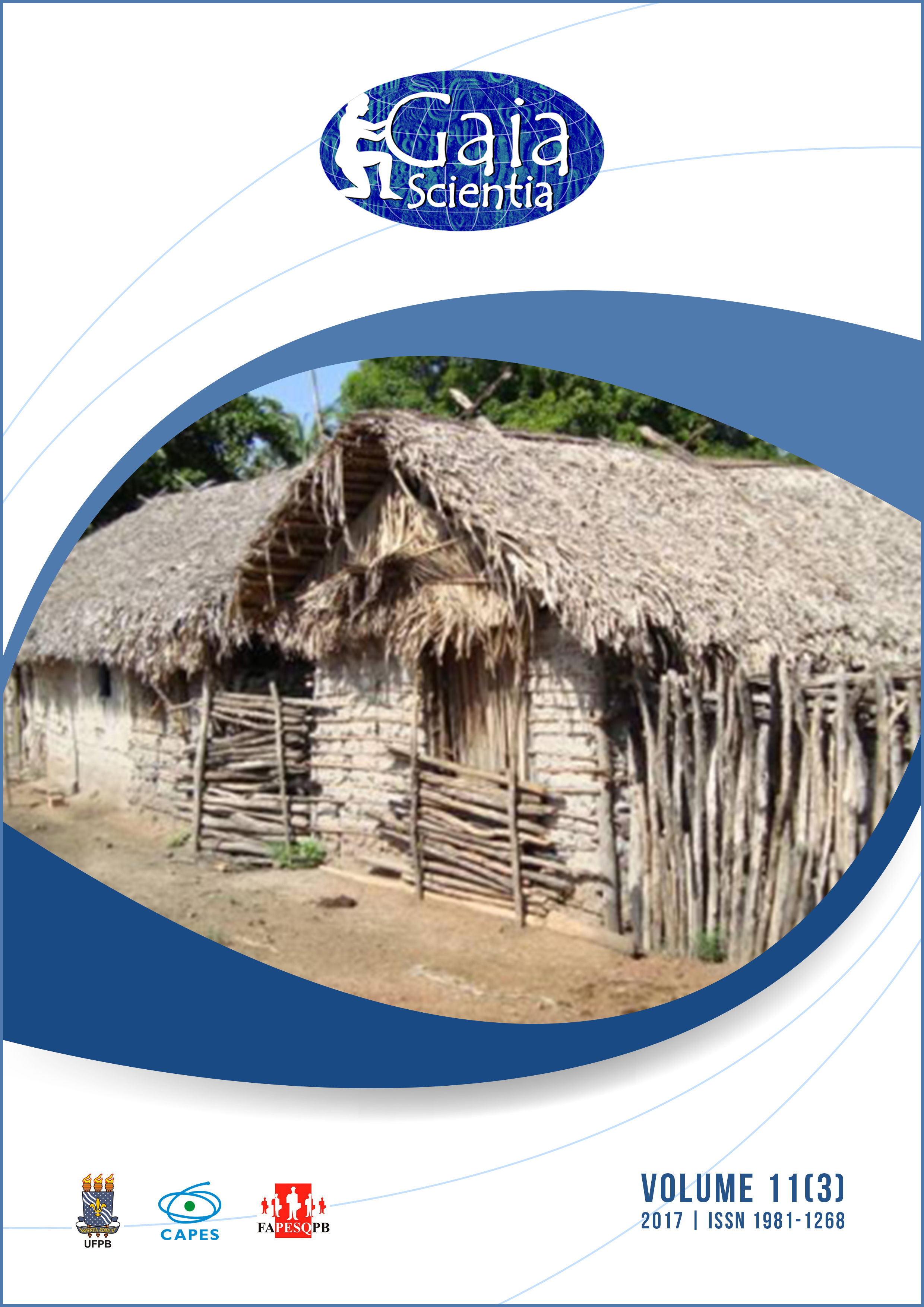Variabilidade interanual da quantidade de carbono absorvido nos biomas nordestinos e sua relação com fatores climáticos
DOI:
https://doi.org/10.22478/ufpb.1981-1268.2017v11n3.29121Abstract
A Produção Primária Líquida (PPL) é uma medida quantitativa da absorção de carbono pelas plantas por unidade de tempo e espaço. A estimativa da PPL para os biomas da região Nordeste do Brasil foi feita com base no modelo de transferência radiativa, mas fatores climáticos como precipitação, radiação e temperatura influenciam na quantidade de carbono sequestrada por estes biomas. Assim, o presente trabalho teve por objetivo conhecer quais os fatores climáticos contribuem para as variabilidades mensal e interanual da PPL. De modo que os resultados mostraram que a variabilidade na PPL decorre das flutuações mensais dos fatores climáticos.
Downloads
References
Alves EDL e Vecchia FAS. 2011. Análise de diferentes métodos de interpolação para a precipitação pluvial no Estado de Goiás. Acta Scientiarum, 33(2):193-197.
Bai J, Chen X, Li L, Luo G e Yu Q. 2014. Quantifying the contributions of agricultural oasis expansion, management practices and climate change to net primary production and evapotranspiration in croplands in arid northwest China. Journal of Arid Environments, 100-101(1):31-41.
Bala G, Joshi J, Chaturvedi RK, Gangamani HV, Hashimoto H e Nemani R. 2013.Trends and Variability of AVHRR-Derived PPL in India. Remote Sensing, 5(2):810-829.
Barbosa HA, Huete AR e Baethgen WE. 2006. A 20-year study of NDVI variability over the Northeast Region of Brazil. Journal of Arid Environments, 67(2):288–307.
Baret F e Olioso O. 1989. Estimation à partit de mesures de réflectance spectrale du rayonnement photosynthétiquement actif absorbé PAR une culture de blé. Agronomie, 9(9):885-895.
Beedlow PA, Tingey DT, Phillips DL, Hogsett WE e Olszyk DM. 2004. Rising atmospheric CO2 and carbon sequestration in forests. Frontiers in Ecology and the Environment, 2(6):315–322.
Berberoglu S, Evrendilek F, Ozkan C e Donmez C. 2007. Modeling Forest Productivity Using Envisat MERIS Data. Sensors, 7(10):2115-2127.
Bradford JB, Hicke JA e Lauenroth WK. 2005. The relative importance of light-use efficiency modifications from environmental conditions and cultivation for estimation of large-scale net primary productivity. Remote Sensing of Environment, 96(2): 246–255.
Crabtree R, Potter C, Mullen R, Sheldon J, Huang S, Harmsen J, Rodman A e Jean C. 2009. A modeling and spatio-temporal analysis framework for monitoring environmental change using PPL as an ecosystem indicator. Remote Sensing of Environment, 113(7):1486–1496.
Churkina G e Running SW. 1998. Contrasting Climatic Controls on the Estimated Productivity of Global Terrestrial Biomes. Ecosystems, 1(2):206-215.
Del Grosso S, Parton W, Stohlgren T, Zheng D, Bachelet D, Prince S, Hibbard K e Olson R. 2008. Global Potential Net Primary Production Predicted From Vegetation Class, Precipitation, And Temperature. Ecology, 89(8):2117–2126.
Deyong Y, Wenquan Z e Yaozhong P. 2008. The role of atmospheric circulation system playing in coupling relationship between spring PPL and precipitation in East Asia area. Environmental Monitoring and Assessment, 145(1-3):135-143.
Fang JY, Piao SL, Tang Z, Peng C e Ji W. 2001. Interannual Variability in Net Primary Production and Precipitation. Science, 293(5535):1723a.
Fensholt R, Sandholt I, Rasmussen MS, Stisen S e Diouf A. 2006. Evaluation of satellite based primary production modeling in the semi-arid Sahel. Remote Sensing of Environment, 105(3):173-188.
Hilker T, Hall FG, Coops NC, Lyapustin A, Wang Y, Nesic Z, Grant N, Black TA, Wuder MA, Kljun N, Hopkins C e Chasmer L. 2010. Remote sensing of photosynthetic light-use efficiency across two forest biomes: Spatial scaling.. Remote Sensing of Environment, 114(12):2863-2874.
Kalnay E, Kanamitsu M, Kistler R, Collins W, Deaven D, Gandin L et al. 1996. The NCEP/NCAR 40-year reanalysis project. Bulletin American Meteorology Society, 77(3):437-471.
Landmann T e Dubovyk O. 2014. Spatial analysis of human-induced vegetation productivity decline over eastern Africa using a decade (2001–2011) of medium resolution MODIS time-series data. International Journal of Applied Earth Observation and Geoinformation, 33(12):76–82.
Mohamed MAA, Babiker IS, Chen ZM, Ikeda K, Ohta K e Kato K. 2004. The role of climate variability in the inter-annual variation of terrestrial net primary production (NPP). Science of the Total Environment, 332(1-3):123–137.
Piao S, Ciais P, Lomas M, Beer C, Liu H, Fang J, Friedlingstein P, Huang Y, Muraoka H, Son Y e Woodward I. 2011. Contribution of climate change and rising CO2 to terrestrial carbon balance in East Asia: A multi-model analysis. Global and Planetary Change, 75(3-4):133-142.
Saldarriaga JG e Luxmoore RJ. 1991. Solar energy conversion efficiencies during succession of a tropical rain forest in Amazonia. Journal of Tropical Ecology, 7(2):233-242.
Tian H, Melillo JM, Kicklighter DW, McGuire AD, Helfrich JVK, Moore B e Charles JV. 1998. Effect of interannual climate variability on carbon storage in Amazonian ecosystems. Nature, 396(12):664-667.
Watson RT e Noble IR. 2005. The global imperative and policy for carbon sequestration. In: Griffiths H e Jarvis PG (Eds), The Carbon Balance of Forest Biomes, Edinburg: Taylor & Francis, Edinburg, UK, p. 1-17.
Zhao M e Running S. 2010. Drought-Induced Reduction in Global Terrestrial Net Primary Production from 2000 Through 2009. Science, 329(5994):940-943.
Zhu L e Southworth J. 2013. Disentangling the Relationships between Net Primary Production and Precipitation in Southern Africa Savannas Using Satellite Observations from 1982 to 2010. Remote Sensing, 5(8):3803-3825.










